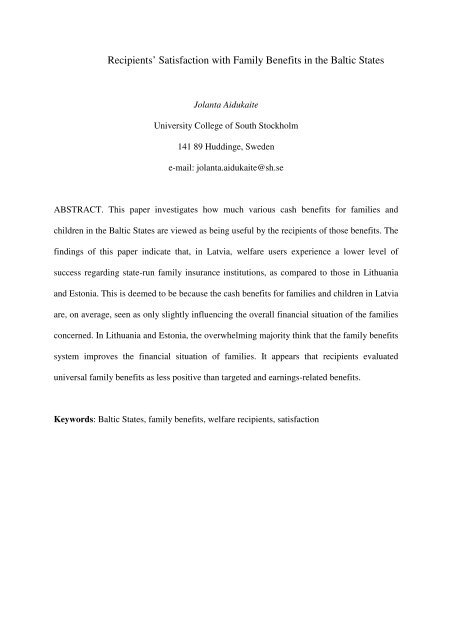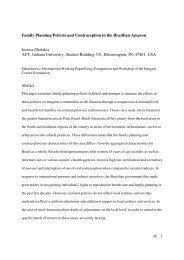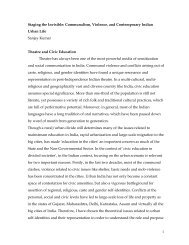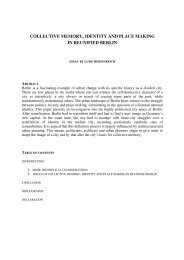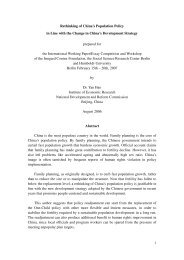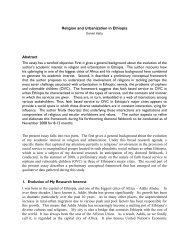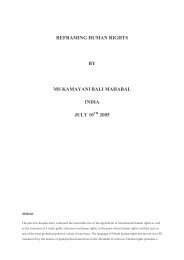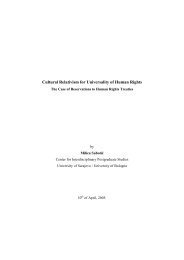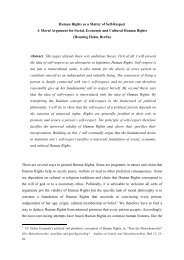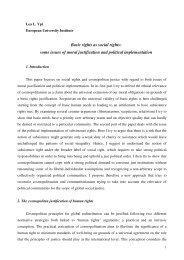Download Paper (PDF) - Irmgard Coninx Stiftung
Download Paper (PDF) - Irmgard Coninx Stiftung
Download Paper (PDF) - Irmgard Coninx Stiftung
You also want an ePaper? Increase the reach of your titles
YUMPU automatically turns print PDFs into web optimized ePapers that Google loves.
Recipients’ Satisfaction with Family Benefits in the Baltic States<br />
Jolanta Aidukaite<br />
University College of South Stockholm<br />
141 89 Huddinge, Sweden<br />
e-mail: jolanta.aidukaite@sh.se<br />
ABSTRACT. This paper investigates how much various cash benefits for families and<br />
children in the Baltic States are viewed as being useful by the recipients of those benefits. The<br />
findings of this paper indicate that, in Latvia, welfare users experience a lower level of<br />
success regarding state-run family insurance institutions, as compared to those in Lithuania<br />
and Estonia. This is deemed to be because the cash benefits for families and children in Latvia<br />
are, on average, seen as only slightly influencing the overall financial situation of the families<br />
concerned. In Lithuania and Estonia, the overwhelming majority think that the family benefits<br />
system improves the financial situation of families. It appears that recipients evaluated<br />
universal family benefits as less positive than targeted and earnings-related benefits.<br />
Keywords: Baltic States, family benefits, welfare recipients, satisfaction
1. Introduction<br />
The three Baltic States, as an example of post-socialist social policy, have been experiencing<br />
social policy reform over a period of more than ten years. Such challenges as declining birth<br />
rates, ageing populations, increasing child poverty and declining family stability have put, in<br />
particular, family policy on the agenda for policy makers to discuss. Current debates in the<br />
Baltic societies focus on the question of how family support systems should be reformed in<br />
order to provide the possibility of a good life for all children. Whether benefits for families<br />
and children should be universal or targeted 1 has been a central question in this debate. The<br />
reform of the family support system in the Baltic States has been mostly driven by economic<br />
opportunities, previous social security structures, advice from global organisations, the<br />
background of policy makers and their understandings of a possible reform (Aidukaite, 2004).<br />
However, the opinions of welfare users have not been so widely taken into account and have<br />
not been sufficiently researched in the Baltics. This paper attempts, from a comparative<br />
perspective, to contribute to the research on the opinions of welfare users in the Baltic<br />
countries.<br />
The aim of this study is to investigate how much various cash benefits for<br />
families and children in Lithuania, Latvia and Estonia are viewed as being useful by recipients<br />
of those benefits. According to the recipients’ views, how much do various cash benefits help<br />
them cope with the social risks associated with raising children Do any differences exist<br />
among the three countries in the degree of satisfaction with various family benefits<br />
To investigate these questions, this paper is organised into six sections. First, the<br />
relevant literature is presented to derive a set of hypotheses that might explain the satisfaction<br />
with various family benefits provided. Next, there is a brief literature review on the situation<br />
of families in Lithuania, Latvia and Estonia. In addition to this, the kind of cash benefits for<br />
1 ‘Targeted’ refers to the term that includes both category-targeted and means-tested benefits.
families and children in the Baltics will also be discussed. Then, the data and methods of this<br />
study will be presented. Afterwards, an empirical analysis will be conducted and answers<br />
given to the questions mentioned in the introduction. Finally, there is a discussion of this<br />
paper’s findings.<br />
2. Theoretical Background<br />
There has been little research conducted on the citizens’ satisfaction with social security<br />
institutions. Nevertheless, a review of existing literature shows that satisfaction varies from<br />
country to country depending not only on spending on social policy, but also on the successful<br />
or unsuccessful performance of the social security institutions. For instance, Kohl and Wendt<br />
(2003) found that among citizens in 15 EU countries the level of satisfaction with health care<br />
was practically not linked to the relative level of health expenditures as measured by the share<br />
of GDP spent on health care. However, they found that the level of satisfaction among the<br />
citizens was strongly correlated with the absolute level of health expenditures measured in<br />
USD ($) per head of population. According to Kohl and Wendt (2003: 20), ‘the economically<br />
more advanced countries of the EU are able to spend more on health in absolute terms and<br />
this leads to better satisfaction with the performance of the health system’.<br />
Additionally, Kohl and Wendt (2003) in their study of the satisfaction of EU<br />
citizens with health care systems have found that some countries are able to organise their<br />
health systems in a way that they produce good quality care with limited resource input. As a<br />
result, this is reflected in high levels of public satisfaction. Thus, the findings of their paper<br />
show that satisfaction or dissatisfaction with social welfare could be related to the degree of<br />
success or failure which the performances of existing institutions are perceived to have had.<br />
Thus, from the reviewed literature it could be assumed that the more welfare<br />
provided (higher absolute spending on family benefits) would result in greater satisfaction<br />
with family benefits in the Baltic States. Alternatively, the successful experience of the family
policy institutions by the welfare recipients (e.g., various family benefits organised in such a<br />
way that improve the material situation of families with children and help them to cope)<br />
contributes towards a greater degree of satisfaction with the family support system in the<br />
countries examined. In the following discussion we will test these assumptions.<br />
3. The Situation of Families with Children in the Baltic States<br />
In order to start a discussion on citizens’ views of the family benefits, it is necessary to know<br />
more about the economic and social situation of families with children in the Baltic States.<br />
Although the economic situation in the Baltic States has stabilised over the last few years,<br />
many studies indicate that families with children still experience an increasing risk of poverty.<br />
Families at particular risk are those who have more than two children, single-parent families,<br />
households where parents are unemployed or disabled, and families living in rural areas<br />
(Gassmann, 2000; Trapenciere et al., 2000; Paas et al., 2004; Pranka, 1999; UNDP, 1999,<br />
2001).<br />
Taking into account housing problems and relatively high unemployment,<br />
together with the risk that more children in a family will contribute to the deterioration of the<br />
living conditions of these families, the number of births has been decreasing in the Baltics.<br />
The fertility rates have dropped and the natural rate of increase per 1,000 of the population is<br />
negative. The situation, particularly in Estonia and Latvia, is reaching crisis point. However,<br />
some studies indicate that the number of births is decreasing not only because of the above<br />
problems, but also the changing family values that lead to family formation being postponed.<br />
New family forms, like cohabitation, are becoming more and more socially acceptable, as are<br />
divorce and remarriage (Pranka, 1999; Kutsar and Tiit, 2002; Stankuniene, 1997, 2002). It<br />
must be noted that it has become common for children to be brought up by one of their<br />
parents, particularly in Latvia and Lithuania, although to a lesser extent in Estonia (Kutsar and<br />
Tiit, 2002; Pranka, 1999; The MSSLL, 2003).
The problems described above (child poverty, family instability and declining<br />
fertility) place heavy burdens on the social protection systems. Governments in the Baltics<br />
have been trying to arrange family support systems so as to address all the aforementioned<br />
problems. However, there is still much to be done in the future. The cash benefits for families<br />
and children are a prominent part of the family support systems of the countries in question.<br />
4. The Kind of Cash Benefits for Families and Children in the Baltics<br />
Policy makers in the Baltic States have taken diverse paths to cope with problems in the field<br />
of family policy. In the Baltic countries, the same schemes can be found that are in many<br />
Western European countries: employment support schemes like maternity and parental leave<br />
insurance; transfer support schemes like childcare benefits and child allowances; some<br />
schemes for single parents and large families, as well as other benefits, such as benefits for<br />
orphans and parents with guardianship duties. However, the previous study (Aidukaite, 2004)<br />
has revealed that there are also significant differences among the Baltic countries that should<br />
be taken into account. The most striking difference between the three Baltic States is that both<br />
Latvia and Estonia suddenly introduced universal child allowances. In Latvia, this form of<br />
benefit is paid monthly up to the child’s 15th birthday or until the child has completed a<br />
secondary education. In Estonia, this kind of benefit is paid up to the child’s 16th birthday or<br />
(in the case of daytime study) up to the age of 19. Lithuania, meanwhile, had a universal<br />
family support system that only paid benefits up to the child’s 3rd birthday. However, from 1<br />
July 2004, a universal child allowance up to the child’s 7th birthday was introduced.<br />
According to the latest news from the Ministry of Social Security and Labour of Lithuania<br />
(see http//www.socmin.lt), from 1 September the universal child allowance will be paid to<br />
each child up to their 9th birthday. Thus, it can be argued that the Estonian and Latvian family<br />
support systems are still more universal than the Lithuanian one (for more about the<br />
difference in the kind of family benefits in the Baltic States see Aidukaite, 2006).
If we examine expenditure on cash benefits for families and children in the three<br />
Baltic States, it is obvious that Estonia spends, in absolute terms, most on benefits for families<br />
and children, while Lithuania and Latvia follow behind in that order. However, the difference<br />
between Lithuania and Latvia is not so great when it comes to expenditure for family support,<br />
given the fact that Lithuania has the largest population as compared to the other Baltic States.<br />
In relative terms, Estonia is also the leader when compared to the other two Baltic countries.<br />
In view of earlier research, it can be expected that because of higher welfare<br />
initiatives (highest absolute spending on family benefits) Estonia’s population should be more<br />
satisfied with the various family benefits provided as compared to Lithuania or Latvia. The<br />
subjective indicators from the omnibus survey make it possible to explore this.<br />
5. Data and Method<br />
The subjective indicators for this study come from a questionnaire carried out as part of an<br />
omnibus social survey in the three Baltic States in 2002 (see for detail description of the data<br />
Aidukaite, 2004). To assess the satisfaction with cash benefits for families and children,<br />
people were asked to say how satisfied they were with various cash benefits provided by the<br />
state. People were asked to answer the following question: Q2: ‘How much have various<br />
family benefits, if you or your family members have received them during the last 10 years,<br />
influenced your family’s financial situation’<br />
People’s satisfaction with various benefits is analysed by using a set of<br />
descriptive statistical techniques. Secondary data (objective indicators) are widely used in this<br />
study too. Aggregate country-level statistics are broadly compared with the survey data. The<br />
real expenditure on cash benefits for families and children is measured by using purchasing<br />
power parities (PPP) which are defined as the rates of currency conversion. This eliminates<br />
the differences in price levels between countries and makes it possible to obtain a comparison<br />
of the real expenditure.
6. Results from the question on the recipients’ views<br />
In order to identify which of the schemes are seen as the most useful for families, all schemes<br />
were ranked. Table 1 shows the ranking for the benefit programs according to the<br />
respondents’ level of satisfaction with those benefits. The benefits that received the highest<br />
share of respondents answering that these improved the families’ situation ‘considerably’ and<br />
‘a little’ are at the top of the ranking in Table 1.<br />
It is obvious that the recipients’ regard the universal child allowance paid up to<br />
the child’s 15th or 16th birthday in both countries (Latvia and Estonia) as the most unhelpful.<br />
On the other hand, maternity (pregnancy) insurance, the birth grant and means-tested benefits<br />
together with family benefit for large families and childcare allowances are considered to be<br />
the most beneficial in Latvia and Estonia. In Lithuania, benefits for particular types of<br />
families (former single parent families, foster families and large families) are viewed as the<br />
most effective, along with benefits for children up to the age of 1 (earnings-related parental<br />
leave and the birth grant).<br />
In order to see in which country the family benefit systems are considered<br />
overall to be the most helpful for families, in the means from the breakdown of all the<br />
answers were assessed for each of the following two items; namely, the mean of the<br />
percentages of the answers for all the schemes for the item ‘satisfied’ as well as the mean<br />
percentages for the item ‘unsatisfied’. It was revealed that in Lithuania and Estonia recipients<br />
are the most satisfied with the overall system of cash benefits for families and children as<br />
compared to Latvia. In Lithuania and Estonia, an overwhelming majority think that the family<br />
support system improves the situation of families (76 per cent). Latvia comes bottom – only<br />
49 per cent of the recipients are satisfied. Estonia and Lithuania have the lowest relative share<br />
of those who think that the family situation has not changed since the family started to receive<br />
various kinds of family support benefits (24 per cent). Latvia has the highest number (almost
51 per cent) of those who feel that the itemised benefit programs have not changed the<br />
family’s overall financial situation.<br />
7. Discussion and Conclusions<br />
The aim of this paper was to investigate how welfare recipients in the three Baltic countries<br />
evaluate the cash benefits for families and children.<br />
The findings of this paper indicate that, in Latvia, people experience a lower level of<br />
success regarding state-run family insurance institutions, as compared to those in Lithuania<br />
and Estonia. This is deemed to be because the cash benefits for families and children in Latvia<br />
are, on average, seen as only slightly influencing the overall financial situation of the families<br />
concerned. In Lithuania and Estonia, the overwhelming majorities think that the family<br />
benefits system improves the financial situation of families.<br />
It should be noted that previous surveys, e.g., in Lithuania, have also revealed that<br />
citizens evaluate family benefits as a relatively effective tool for alleviating poverty, and view<br />
them as beneficial (Stankuniene et al., 2003).<br />
Many targeted and earnings-related benefits gained substantial approval among<br />
populations in all three countries. However, the universal benefits were rated lowest as<br />
compared to other types of benefits in all Baltic States and they lowered considerably the<br />
degree of general satisfaction with the overall family benefits system in those countries, in<br />
particular in Estonia and Latvia.<br />
Thus, this study, on the one hand, demonstrates that higher benefit levels in many<br />
cases appear to result in higher degrees of satisfaction with those benefits. However, the level<br />
of benefits seems unrelated to levels of satisfaction with benefits for large families and<br />
means-tested benefits. These kinds of benefits receive very high ratings even though monetary<br />
amounts are small. This is not surprising since poverty among families with children is<br />
relatively high in the Baltic States as was noted in the previous sections and particularly
among large families. Yet, we should also keep in mind that these kinds of benefits are given<br />
to a small proportion of the population and these people may receive this benefit on top of<br />
other benefits. However, the results still show the achievement of the design of these benefits.<br />
Nevertheless, a more in-depth investigation to prove this is needed.<br />
Thus, this study, to some extent, supports both assumptions posed in the<br />
theoretical section of this paper. The higher the welfare efforts (absolute spending), the<br />
greater the satisfaction with the welfare institutions. But it seems that the successful<br />
performance of welfare institutions also matters when concerning the citizens’ satisfaction<br />
with the welfare arrangements. Lithuanian policy makers with fewer resources produced<br />
similar satisfaction levels as in Estonia. However, spending on family benefits is highest in<br />
Estonia.<br />
Policy-makers in many post-socialist societies have since the collapse of the<br />
Soviet regime been faced with a dilemma that concerns the question as to whether emphasis<br />
should be placed on universalism or targeting the reformation of a social policy. This study<br />
puts forward a discussion about whether universalism is always more legitimate than<br />
targeting. In transitional economies, in which resources are highly constrained, some forms of<br />
universal benefits could turn out to be very expensive in relative terms, without being seen as<br />
useful or legitimate forms of help to families.
Table 1. Ranking of the cash benefits by the recipients in the Baltics<br />
Lithuania Latvia Estonia<br />
1. Family benefit<br />
for large families<br />
1. Birth grant 1. Family benefit<br />
for large families<br />
2. Categorytargeted<br />
benefits<br />
up to the child’s<br />
16th birthday<br />
3. Former single<br />
parent allowance<br />
2. Maternity<br />
insurance<br />
3. Former family<br />
benefit for large<br />
families<br />
2. Birth grant<br />
3. Means-tested<br />
benefits<br />
4. Birth grant 4. Means-tested<br />
benefits<br />
4. Maternity<br />
insurance<br />
5. Parental<br />
insurance<br />
6. Maternity<br />
insurance<br />
7. Means-tested<br />
benefits<br />
8. Childcare<br />
allowance up to<br />
the child’s 3rd<br />
birthday<br />
5. Childcare<br />
allowance up to<br />
the child’s 3rd<br />
birthday<br />
6. Allowance for<br />
the child to start<br />
their schooling<br />
(means-tested)<br />
7. Former single<br />
parent allowance<br />
8. Child allowance<br />
up to the child’s<br />
15th birthday<br />
5. Childcare<br />
allowance up to<br />
the child’s 3rd<br />
birthday<br />
6. Allowance for<br />
the child to start<br />
their schooling<br />
7. Single parent<br />
allowance<br />
8. Child allowance<br />
up to the child’s<br />
16th birthday<br />
References<br />
Aidukaite, J. (2004) The Emergence of the Post-Socialist Welfare State – The Case of the Baltic States: Estonia,<br />
Latvia and Lithuania. Södertörns Högskola. Elanders Gotab, Stockholm.<br />
Gassmann, F. (2000) Who and Where are Poor in Latvia Social Policy Research Series. The Ministry of<br />
Welfare of the Republic of Latvia, United Nations Development Programme, (Riga, Latvia).
Kohl, J. and Wendt, C. (2003) ‘Satisfaction with Health Care Systems: A Comparison of EU Countries’, <strong>Paper</strong><br />
presented at the Fifth Conference of the International Society for Quality-of-Life Studies “Challenges for<br />
Quality of Life in Contemporary Societies”, Frankfurt, 20–24 July.<br />
Kutsar, D. and Tiit, E-M. (2002) ‘Making Family-Related Decisions and Impacting Social-Political Factors’,<br />
<strong>Paper</strong> presented at the 15th ISA Congress of Sociology, RC6: Family Research, Brisbane, Australia, 7–12<br />
July.<br />
Ministry of Social Security and Labour of Lithuania (MSSLL) (2003) Social Report 2002 (Vilnius).<br />
Ministry of Social Security and Labour of Lithuania (MSSLL) (2004) Valstyb÷s parama besilaukiančioms<br />
kūdikio moterims ir vaikus auginančioms šeimoms nuo 2004 m. liepos 1 d. http://www.socmin.lt/popup.php<br />
[17 June 2004].<br />
Nielsen, J. (ed.) (2003) Nordic/Baltic Social Protection Statistics 2000: Scope, Expenditure and Financing<br />
(Nordic Social-Statistical Committee).<br />
Paas, T., Hinnosaar, M., Masso, J. and Szirko, O. (2004) ‘Social Protection Systems in the Baltic States’, Report.<br />
University of Tartu: Tartu.<br />
Pranka, M. (1999) ‘The State of Children and Families in Latvia’, in Tane Lace (ed.), Children and Families in<br />
Latvia: Situation Analysis (Riga), pp. 4–7.<br />
Stankuniene, V. (2002) ‘Gimstamunas ir šeima’, in Lietuvos gyventojai 1990-2000 (Vilnius), pp. 25–37.<br />
Stankuniene, V. (ed.), Jonkaryte, A., Mikulioniene, S., Mitrikas, A.A. and Maslauskaite, A. (2003) Seimos<br />
revoliucija Issukiai seimos politikai (Vilnius: Socialiniu tyrimu institutas).<br />
Trapenciere, I., Rungule, R., Pranka, M., Lace, T. and Dudwick, N. (2000) ‘Listening to the Poor: Social<br />
Assessment of Poverty in Latvia’, Report on Research Findings (March–June 1998), (Riga, Latvia).<br />
United Nations Development Programme (UNDP) (1999) Poverty Reduction in Estonia: Background and<br />
Guidelines, 1999 (University of Tartu, Ministry of Social Affairs of Estonia, United Nations Development<br />
Programme [UNDP], Tartu).<br />
United Nations Development Programme (UNDP) (2000) Poverty Reduction in Estonia, Latvia and Lithuania,<br />
Part II – Poverty in Lithuania; Poverty in Estonia; and Poverty in Latvia.


